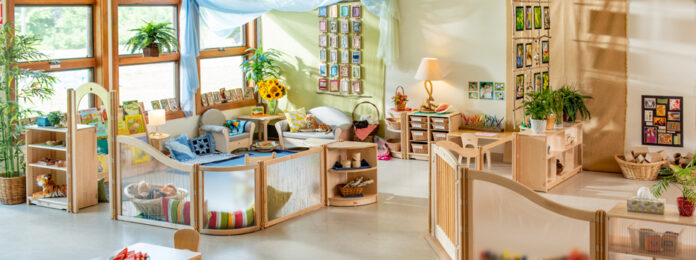The role of a classroom’s physical environment in learning is typically over looked. Most educators focus on pedagogy, content, and interpersonal dynamics, giving little formal consideration to the physical contexts in which teaching and learning occur (Morrow & Rand, in press). Recent studies indicate, however, that manipulating classroom environments can yield developmental dividends, especially when it encourages and supports the kind of play that psychologists and educators generally agree is a young child’s primary avenue to learning and development.
Observations of children at play have pointed out the functional uses of literacy skills which children incorporate into their play themes. Roskos (1988) observed and described a range of literacy-related behaviors during children’s play such as paper handling, storytelling, and early attempts at reading and writing. Literacy development in young children may occur within the context of play. Play is an ideal setting which allows the young child to practice, elaborate, and extend emergent literacy abilities.
Careful attention to the physical arrangement of a classroom and the selection of materials is essential to instructional success. Including reading/writing materials in dramatic play areas can increase the type and quantity of voluntary literacy behaviors among children (Rivlin & Weinstein, 1984;Weinstein, 1977). Studies of literacy activities in early childhood (Morrow, 1987, 1989; Morrow & Weinstein, 1986) indicate that the physical environment is essential in supporting and actively influencing literacy learning.
Preschool and kindergarten children are likely to engage in more voluntary literacy behaviors during free-play periods when literacy materials are introduced and teachers guide children to vise those materials.
Another important variable is the social environment of the classroom, in particular, the role of the teacher. Vygotsky (1978) maintained that children learn higher psychological processes through the social environment when an adult or “more literate other” plays an active role in that social content. Similarly, Holdaway (1979) proposed that the adult provides an “emulative model” for the child’s literacy development by encouraging and assisting the child based on the child’s needs and level of ability.
Results of the project on which the findings of this article were based, as well as other similar research efforts, point to some general guidelines for stimulating literacy during play:
1. Reading and writing materials which are incorporated into children’s thematic play activities are likely to generate functional and practical emerging literacy behaviors.
2. Materials should be kept in clearly marked and defined containers, so that they are accessible and easily put away.
3. Teachers should suggest uses for materials, model literacy behaviors, and change materials periodically to keep the interest level high.
4. All levels of development should be accepted, and reading or writing attempts should be recognized as legitimate literacy behaviors.
5. Observational anecdotes of literacy behaviors and examples of attempted writing can be kept to aid in assessment (Morrow, 1989; Schickedanz, 1986).
6. Teachers in Grades 1 to 3 might consider this type of play activity valuable in developing literacy skills for the children they teach.
Analysis:
This article presents an interesting take on the value of incorporating play into a child’s education and furthermore the emulative affect that teachers have on students development when engaging in playful activities. It first emphasizes the typically overlooked factor in a student’s learning, the surrounding environment in which they learn. This is relevant to my thesis because I am striving to critically analysis the home learning environment and what it lacks in comparison to a traditional school environment. I found the idea that thematic and dramatic play activities generate functional and practical literacy behaviors as well as keep interest levels high (which is a challenge for students in virtual learning). How can the idea of playful design be just as equally incorporated into an online learning setting?
Source: https://www.jstor.org/stable/20200675?seq=1#metadata_info_tab_contents




